Before you turn on another expensive greenhouse heater, consider this: Traditional greenhouses can lose up to 80% of their heat overnight, forcing growers to rely on costly fossil fuels. In fact, heating costs can account for 50% of a greenhouse’s total expenses—a major financial burden.
But what if there was a way to trap the sun’s heat naturally, reduce costs, and grow sustainably—all without relying on expensive energy?
That’s where passive solar greenhouses come in. By using smart design, thermal mass, and natural sunlight, they keep plants warm with minimal external energy. In this article, we’ll explore why passive solar greenhouses are gaining popularity, how they work, and how you can design one for maximum efficiency and year-round growing.
What to Expect in This Blog:
What is a Passive Solar Greenhouse?
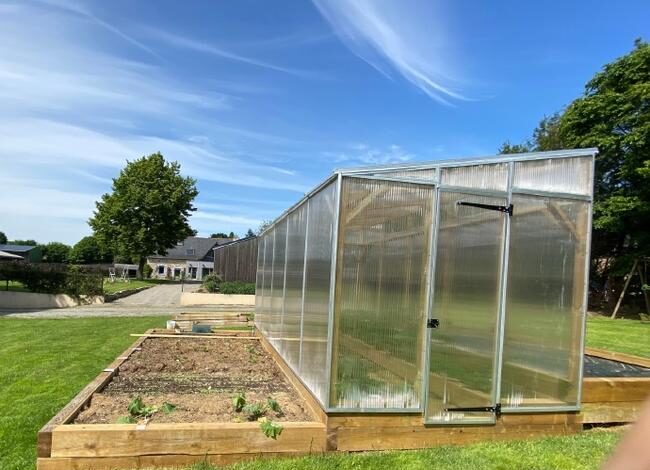
Let’s start by defining what a passive solar greenhouse is.
A common misconception is that a passive solar greenhouse doesn’t need any heating. While it’s true that the greenhouse uses the sun’s energy to heat itself, it’s not that there’s no heat source at all. Rather, the greenhouse captures and stores the sun’s heat using carefully selected materials, and then reuses that energy without requiring additional heating systems.
In a passive solar greenhouse, sunlight is absorbed by thermal mass materials like water barrels, stone walls, or even the soil itself during the day. These materials slowly release the stored heat at night, keeping the greenhouse warm. The design of the greenhouse, including its orientation and glazing materials, is key to effectively capturing and holding this heat. By understanding the sun’s path and the thermal properties of the materials, the greenhouse works passively to maintain a stable environment for plants.
Unlike solar greenhouses that actively use photovoltaic panels to generate electricity, passive solar greenhouses rely solely on the sun’s thermal energy for heating. While the goal is to reduce external energy use, a small amount of electricity—such as for fans or automated systems—can enhance the efficiency of the greenhouse, ensuring it operates smoothly year-round.
Why is a Passive Solar Greenhouse Necessary?
Greenhouses are designed to create a controlled environment for plants, but traditional greenhouses have a major challenge: keeping temperatures stable without excessive energy use.
Most greenhouses lose heat rapidly at night, making artificial heating essential—especially in cold climates. However, this leads to high energy costs and dependence on fossil fuels, which is neither economical nor sustainable in the long run.
A passive solar greenhouse solves this problem by naturally capturing and storing solar heat, reducing or even eliminating the need for external heating. This makes it an ideal choice for growers looking to:
- Cut heating costs in winter and reduce long-term energy expenses.
- Extend the growing season without expensive climate control systems.
- Build a more sustainable, self-sufficient growing space, even in remote areas.
With rising energy prices and increasing concerns about sustainability, passive solar greenhouses offer a smart, low-maintenance alternative to conventional greenhouse designs. They allow growers to work with nature, rather than against it—using good design instead of costly energy to maintain ideal growing conditions.
Advantages of a Passive Solar Greenhouse
A passive solar greenhouse offers several key benefits that make it an efficient and sustainable choice for growers. Here’s why it stands out:
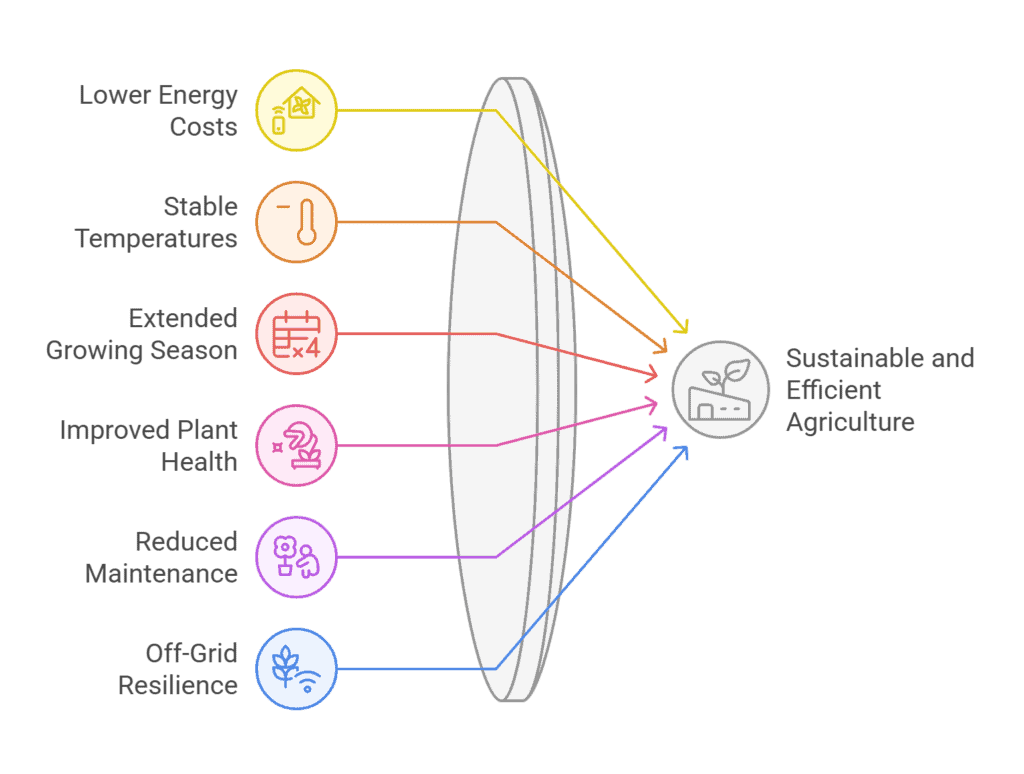
1. Lower Energy Costs
Since a passive solar greenhouse captures and stores heat from the sun, it reduces or even eliminates the need for external heating. This means lower electricity or fuel expenses, especially in colder months.
2. More Stable Temperatures
Thermal mass materials, like water barrels or stone walls, absorb heat during the day and release it at night. This keeps the greenhouse warmer at night and prevents extreme temperature swings that could harm plants.
3. Extended Growing Season
With better heat retention, plants can grow for more months of the year, even in cold climates. This allows growers to produce fresh food outside of the usual growing season.
4. Improved Plant Health and Growth
Stable temperatures and humidity levels help reduce plant stress and lower the risk of fungal diseases. This leads to healthier plants, higher yields, and better-quality produce.
5. Reduced Maintenance and Operating Effort
Since passive solar greenhouses rely on natural heat retention rather than complex mechanical systems, they require less ongoing maintenance. Growers spend less time adjusting temperature controls and more time focusing on plant care.
6. Resilience in Remote or Off-Grid Areas
Because they don’t rely on constant external energy, passive solar greenhouses are ideal for locations with limited electricity access or high energy costs. They offer a self-sufficient growing solution.
7. Sustainable and Eco-Friendly
By relying on natural solar energy instead of fossil fuels, passive solar greenhouses help reduce carbon emissions. They provide a greener way to grow food while minimizing environmental impact.
Disadvantages of a Passive Solar Greenhouse
While a passive solar greenhouse has many advantages, it also comes with some challenges. Understanding these limitations can help growers make better decisions when designing and using one.
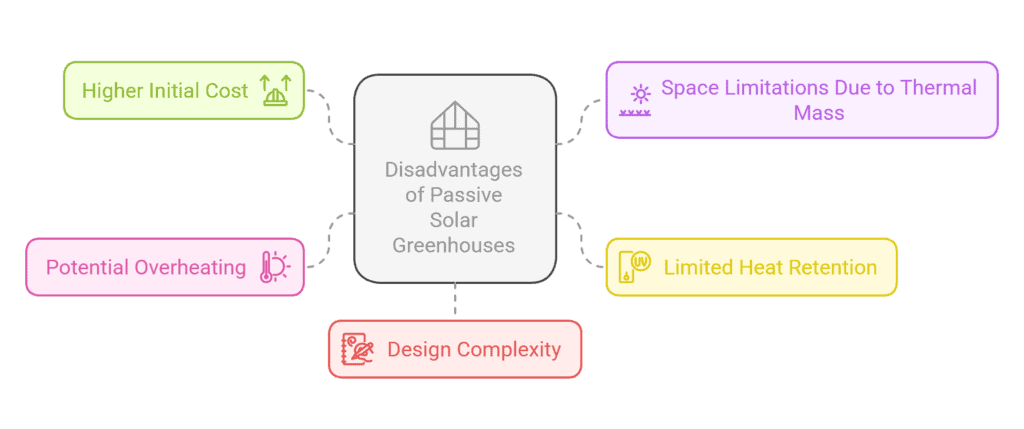
1. Higher Initial Cost
Building a passive solar greenhouse requires specific materials like thermal mass, insulation, and well-planned glazing. These materials, along with a solid structural design, often make the initial investment higher than a traditional greenhouse.
2. Space Limitations Due to Thermal Mass
To effectively store and release heat, passive solar greenhouses rely on thermal mass materials such as water barrels or stone walls. These take up valuable growing space, reducing the total area available for plants.
3. Limited Heat Retention on Cloudy or Extremely Cold Days
Passive solar greenhouses depend on sunlight. During extended cloudy periods or in extreme winter conditions, heat retention may not be enough, requiring backup heating systems to prevent temperature drops that could harm plants.
4. Potential Overheating in Warm Seasons
While these greenhouses are excellent at trapping heat in winter, they can also get too hot in the summer. Without proper ventilation—such as automated vents or shading systems—high temperatures can stress or damage plants.
5. Design Complexity and Planning Requirements
Unlike standard greenhouses, passive solar greenhouses require precise design, including orientation, insulation, and material selection. A poorly designed system may not function as expected, leading to inefficiencies and extra costs for modifications.
How to Optimize Passive Solar Greenhouse Performance?
A well-designed passive solar greenhouse can maximize energy efficiency and provide a stable growing environment. Here are key ways to improve its performance:
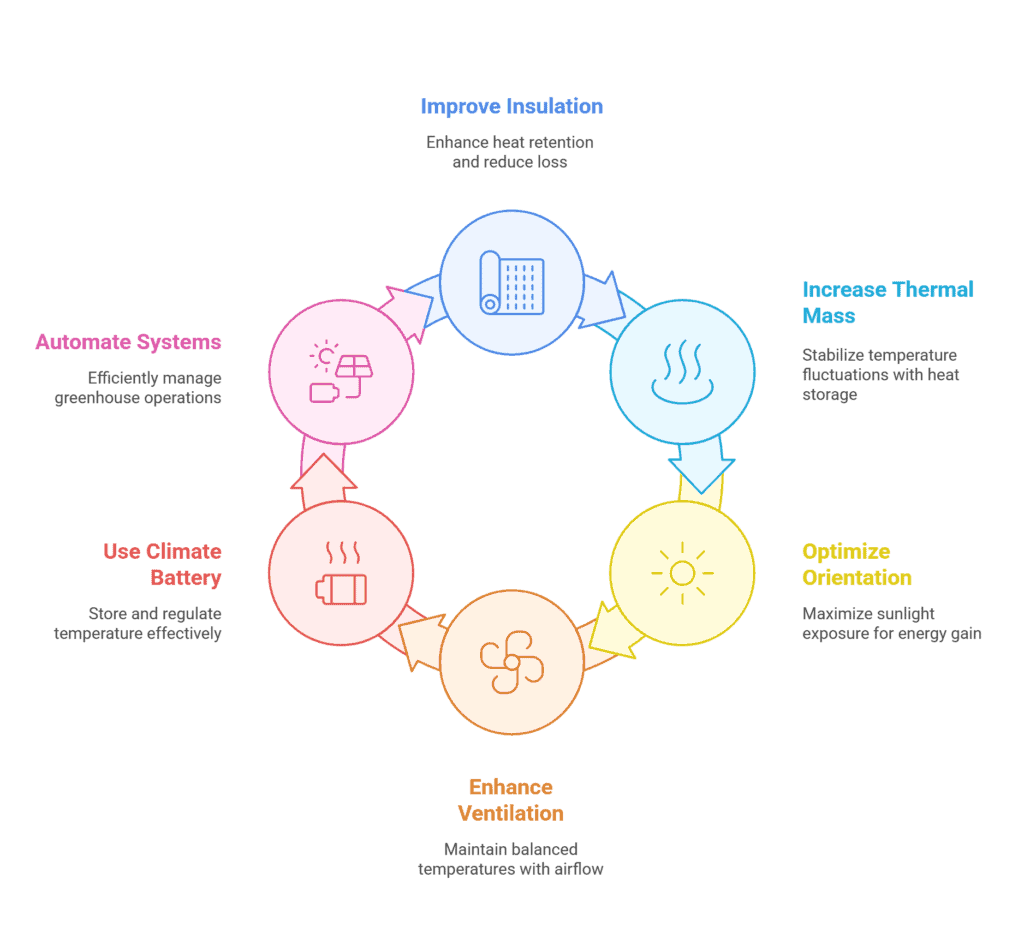
1. Improve Insulation to Reduce Heat Loss
A well-insulated greenhouse holds heat longer and reduces energy loss. Consider:
- Double-layer polycarbonate or inflated dual-layer film for better thermal resistance.
- Thermal curtains that automatically deploy at night to retain warmth.
- Well-insulated north, east, and west walls to minimize heat escape.
2. Increase Thermal Mass for Better Heat Storage
Thermal mass materials help stabilize temperature fluctuations:
- Water barrels (painted black) absorb heat quickly and release it at night.
- Stone, bricks, or dense flooring store heat for longer but take more time to warm up.
- Soil-based heat storage combined with underground tubing (climate battery) can improve long-term temperature regulation.
3. Optimize Orientation and Sunlight Exposure
Maximize solar gain by correctly positioning your greenhouse:
- Face south (in the northern hemisphere) to capture the most winter sunlight.
- Adjust roof angle based on latitude to optimize seasonal light absorption.
- Use external shading structures in hot climates to prevent overheating in summer.
4. Enhance Ventilation to Prevent Overheating
Proper airflow keeps temperatures balanced:
- Automated roof and side vents help release excess heat.
- Solar-powered exhaust fans regulate airflow efficiently without external electricity.
- Shade cloths or reflective coatings minimize overheating in warm seasons.
5. Use a Climate Battery for Additional Temperature Control
A climate battery system stores excess heat underground and releases it when needed:
- Uses buried tubing to circulate warm air into the soil during the day and extract it at night.
- Works well in areas with large temperature swings, reducing reliance on external heating and cooling.
6. Automate Key Systems with Solar Energy
Adding solar-powered automation increases efficiency:
- Temperature-controlled vents and fans adjust airflow automatically.
- LED grow lights powered by solar panels can extend daylight hours in winter.
- Smart irrigation systems optimize water use, reducing waste.
Key Structures and Materials in a Passive Solar Greenhouse
A strong structure and the right materials are essential for a passive solar greenhouse to function efficiently. The greenhouse design should maximize solar gain, store heat effectively, and ensure durability.
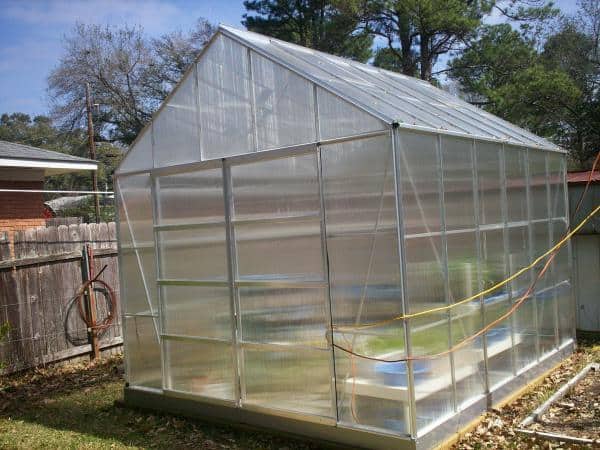
1. Structural Frame: Strength, Stability, and Longevity
The greenhouse frame provides support for glazing, insulation, and thermal mass. Choosing the right frame affects durability, maintenance, and how well the greenhouse retains heat.
- Common Frame Materials:
- Galvanized Steel – Strong, durable, and corrosion-resistant, ideal for large commercial greenhouses.
- Timber – Cost-effective for small greenhouses but requires maintenance to prevent rot.
- Aluminum – Lightweight and rust-resistant, but less suitable for heavy-duty applications.
- Hybrid (Steel + Wood) – Balances cost and strength, often used in mid-sized greenhouses.
- Best choice: Galvanized steel frames are ideal for long-term, commercial use due to their high strength and low maintenance.
2. Roof and Structural Design: Maximizing Solar Gain and Efficiency
The shape and orientation of a greenhouse affect how well it captures and retains solar energy.
- Common Roof Designs:
- Traditional Hoop House – Economical and easy to construct but has limited thermal mass storage.
- A-Frame Roof – Good for snowy regions, allowing snow to slide off, but may require additional insulation.
- Gothic Arch Roof – Stronger against wind and snow, ideal for areas with harsh weather.
- Solar Sloped Roof – Designed to optimize solar panel placement and maximize passive solar heating.
- Best choice:
- For passive solar efficiency, a south-facing sloped roof with an optimal angle (adjusted for latitude) captures more sunlight in winter.
- If integrating photovoltaic panels, ensure the structure can support the added weight and that shading from panels does not reduce solar gain inside the greenhouse.
3. South-Facing Glazing for Maximum Solar Gain
The south-facing wall and roof should allow the most sunlight into the greenhouse:
- Materials: Glass, twin-wall polycarbonate, or polyethylene film.
- Best choice: Twin-wall polycarbonate balances insulation and light transmission, making it ideal for most climates.
- Design tip: Ensure the angle of the glazing matches the sun’s position in winter for maximum efficiency.
4. Well-Insulated North, East, and West Walls to Reduce Heat Loss
Since the sun mostly enters from the south, the other walls should be insulated to prevent heat loss:
- Materials: Rigid foam insulation, insulated metal panels, or earth-bermed walls.
- Best choice: Thick, well-insulated walls with an R-value of at least R-15 to R-30, depending on the climate.
- Design tip: Some growers build earth-sheltered north walls for natural insulation and extra thermal mass.
5. Thermal Mass to Store and Release Heat
Thermal mass absorbs heat during the day and releases it at night, stabilizing the temperature:
- Common options:
- Water barrels (painted dark for better heat absorption).
- Stone or brick walls (slow heat release, ideal for long-term heat retention).
- Soil-based storage (combined with underground tubing for climate battery systems).
- Best choice: Water has the highest heat capacity per volume, making it the most effective option.
6. Ventilation System to Prevent Overheating
Even in winter, greenhouses can get too hot. Good airflow is essential to regulate temperature:
- Vent types:
- Roof vents (hot air rises and escapes naturally).
- Side vents (cross-ventilation for consistent airflow).
- Solar-powered fans (automatic cooling with no extra energy cost).
- Design tip: Automated vent openers (wax-based or solar-powered) ensure the greenhouse stays cool without manual adjustments.
7. Floor and Ground Insulation to Prevent Heat Loss
The ground can be a major source of heat loss if not properly insulated:
- Materials:
- Insulated ground cover (foam board under the soil to prevent heat escape).
- Gravel or stone floors (help absorb heat and provide drainage).
- Earth-bermed edges (using soil as a natural insulator around the foundation).
- Best choice: Combining ground insulation + thermal mass flooring improves heat retention.
8. Optional Climate Battery for Additional Temperature Control
A climate battery system (underground heat storage) can further stabilize temperatures:
- How it works:
- During the day, excess warm air is pumped underground through a network of pipes.
- At night, the stored heat is released back into the greenhouse.
- Best choice: Works best in areas with large temperature fluctuations or for growers who want extra thermal stability.
Cost Factors of a Passive Solar Greenhouse
The cost of building a passive solar greenhouse varies based on several key factors. Understanding these factors can help growers plan their budget and make cost-effective decisions.
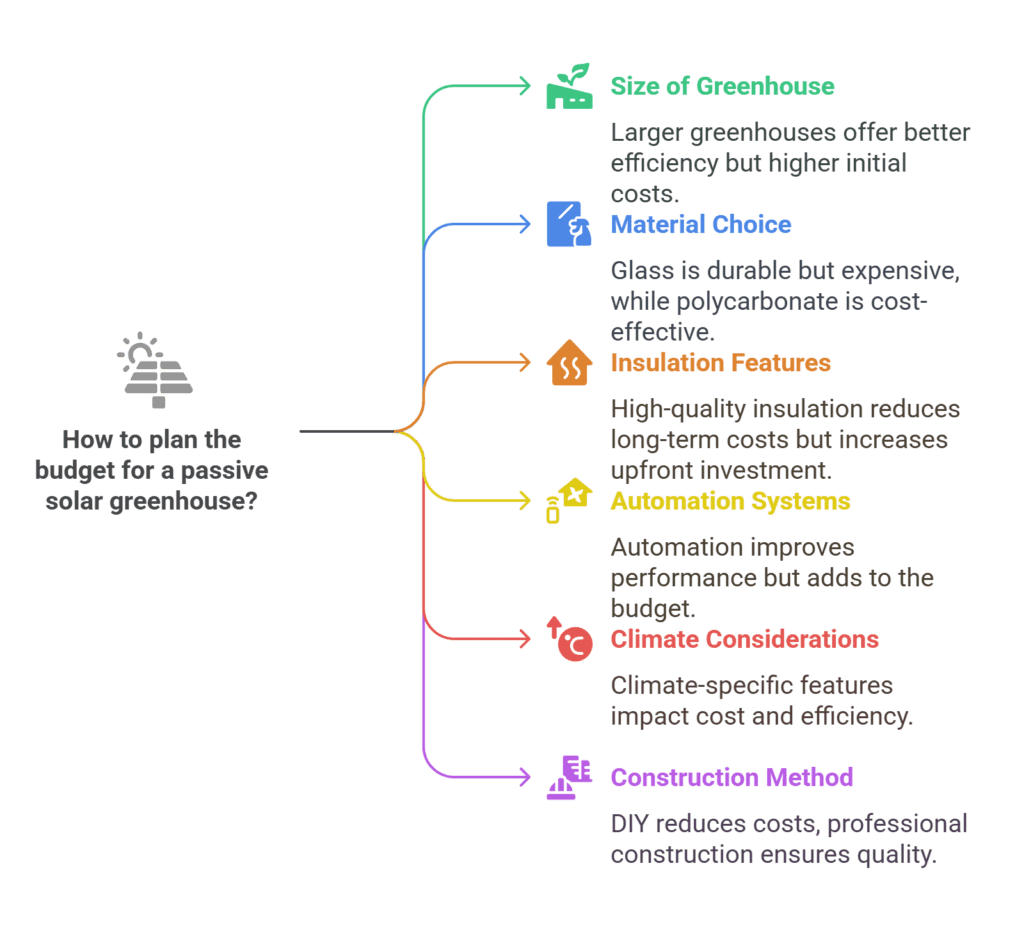
1. Size of the Greenhouse
Larger greenhouses require more materials, insulation, and thermal mass, which increases the overall cost. However, they are often more efficient per square meter because they retain heat better than smaller structures. A small greenhouse may cost less upfront, but a larger one can offer better long-term savings due to improved heat retention and growing capacity.
2. Choice of Materials
The type of materials used for glazing, insulation, thermal mass, and structure significantly impacts the cost. Glass is more expensive but durable, while polycarbonate is cost-effective and provides better insulation. The frame material also matters—galvanized steel is strong but costly, while wood is cheaper but requires maintenance. Choosing high-quality insulation can also increase upfront costs but reduce long-term heating expenses.
3. Insulation and Heat Retention Features
The better a greenhouse is insulated, the more efficiently it retains heat, but high-quality insulation adds to the initial cost. Well-insulated north, east, and west walls, double-glazed polycarbonate, and thermal curtains all improve heat retention but require extra investment. Thermal mass materials, such as water barrels or stone walls, also contribute to cost but play a crucial role in temperature stability.
4. Automation and Ventilation Systems
Automated systems, such as temperature-controlled vents, solar-powered fans, and automated shading, improve greenhouse performance but add to the overall budget. Manual systems are cheaper initially but require ongoing monitoring and labor. Investing in automation reduces maintenance effort and ensures consistent temperature control, especially in larger greenhouses.
5. Climate and Location Considerations
A greenhouse built in colder climates may need extra insulation, more thermal mass, and even backup heating, increasing costs. In contrast, in warmer regions, additional ventilation and shading may be necessary to prevent overheating. The availability and cost of materials also vary by location, impacting the overall budget.
6. DIY vs. Professional Construction
A DIY-built greenhouse can significantly lower costs, especially if the grower already has construction skills. However, professional construction ensures better structural integrity, proper insulation, and long-term durability. Hiring experts increases the initial investment but may prevent costly mistakes in design and execution.
Passive Solar Greenhouse vs. Solar Greenhouse: What’s the Difference?
Passive solar greenhouses and solar greenhouses (with photovoltaic panels) both utilize solar energy, but they work in different ways. The table below provides a quick and clear comparison of their key differences.
| Feature | Passive Solar Greenhouse | Solar Greenhouse (PV-Integrated) |
| Main Energy Source | Captures and stores solar heat passively | Uses photovoltaic (PV) panels to generate electricity |
| Heating Method | Uses thermal mass (water barrels, stone walls) to store heat | Can power electric heaters using solar energy |
| Cooling Method | Natural ventilation, shading, thermal mass regulation | Can use solar-powered fans and automated cooling systems |
| Energy Dependence | Minimal or no external energy needed | Can be self-sufficient if PV system generates enough power |
| Construction Cost | Lower initial cost, mainly material-dependent | Higher cost due to solar panels and electrical systems |
| Long-Term Savings | Saves on heating costs, but performance depends on weather | Generates its own electricity, reducing long-term energy expenses |
| Maintenance Needs | Low (no mechanical heating/cooling systems) | Medium to high (solar panels, inverters, and batteries need upkeep) |
| Best For | Growers looking for a low-energy, sustainable heating solution | Those needing off-grid power, automation, and energy flexibility |
| Challenges | Less effective in extended cloudy/cold conditions | Higher upfront cost and technical complexity |
| Ideal Use Cases | Remote areas, cold climates, and low-maintenance growing | Commercial farms, areas with high solar potential |
Choosing between a passive solar greenhouse and a solar-powered greenhouse depends on your energy needs, budget, and climate conditions.
- If energy independence and automation are a priority, a solar greenhouse with PV panels is the better choice.
- If low-cost, sustainable heat retention is your main goal, a passive solar greenhouse will be more practical.
Or would you like to integrate both? Hybrid designs can combine passive solar heating with PV-powered automation for maximum efficiency.
Conclusion
A passive solar greenhouse is a cost-effective, energy-efficient, and low-maintenance way to grow plants all year. It stores the sun’s heat and reduces heating costs, making it a great choice for sustainable farming.
Compared to traditional greenhouses, it cuts energy bills, stabilizes temperatures, and requires less maintenance. Though the initial cost may be higher, the long-term savings make it a smart investment.
- If you want to lower costs and grow more efficiently, focus on good insulation, proper ventilation, and smart thermal mass use.
- If you live in cold or cloudy areas, consider a climate battery or backup heating for better performance.
- If you run a commercial farm, combining passive solar heating with automation can improve productivity and reduce labor costs.
A well-designed passive solar greenhouse works with nature, not against it. With the right planning, it can provide a reliable, sustainable, and profitable growing solution for farmers, gardeners, and greenhouse operators worldwide.

